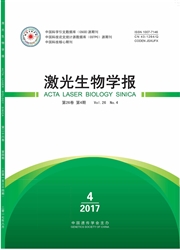

 中文摘要:
中文摘要:
Bax(Bcl-2-associated Xprotein)是bcl-2家族中的一个很重要的促凋亡蛋白,在正常的细胞生理状态下,主要分布在细胞质,在UV等凋亡刺激因子的作用下,则从细胞质转位到线粒体从而诱导细胞色素C的释放,最终引起细胞凋亡。缺失Bax的细胞对UV诱导的细胞凋亡有抗性,因此研究Bax的特性有助于深入了解UV诱导的细胞凋亡信号转导通路的分子机制。以前的研究大都采用生化的手段,无法在活细胞上实时动态的观察Bax蛋白的变化过程。运用激光共聚焦扫描显微成像技术单细胞实时检测了UV诱导的细胞凋亡过程中Bax的动态变化过程。研究结果表明:UV诱导的细胞凋亡过程中Bax的转位大约起始于UV照射后5h~6h,整个转位过程持续20min~30min。
 英文摘要:
英文摘要:
Bax, a proapoptotic member of the Bcl-2 family, localizes largely in the cytoplasm but redistributes to mitochondria and undergoes oligomerization to induce the release of apoptogenic factors such as cytochrome c in response to apoptotic stimuli. Cells deficient in Bax are resistant to UV-induced apoptosis. Thus, studying Bax translocation is very important for us to understand the cellular signaling mechanisms mediating UV-induced apoptosis. Most of previous studies on Bax translocation were done by western blotting or immunoblotting, but these techniques could not monitor the translocation of intracellular Bax in real time. In this study, we monitored the dynamics of Bax translocation during UV- induced apoptosis in single living cell using laser confocal microscope imaging technique. These results demonstrated that Bax translocation was initiated at 5 h - 6 h after UV irradiation, the average duration of this course was 20 min - 30min.
 同期刊论文项目
同期刊论文项目
 同项目期刊论文
同项目期刊论文
 期刊信息
期刊信息
